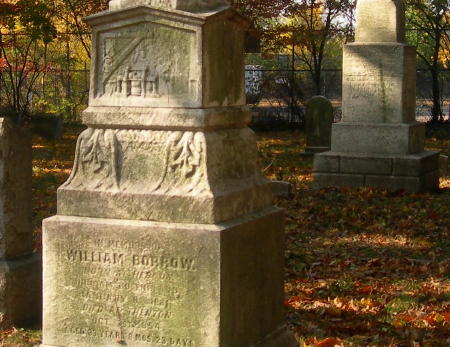





|
|
|
|
November 12, 2005
Give (or take) a century of initiative
There's a curious slogan written in giant letters on the bridge which spans the Delaware River between Pennsylvania and Trenton, New Jersey. Here's what it looked like earlier today:  I have no idea how many times I've driven across that bridge and wondered about the meaning of the message, but I always assumed it had something to do with days long in Trenton's past, as the classically elegant architectural feactures of Trenton's crumbling downtown area stand at once stand in sharp contrast against the severe economic depression of the city today just as they seem to recoil against it. (I'm surprised today's wannabe Ceausescus haven't done to them what that bastard did to Bucharest....) Were it not for this blog's ongoing interest in America's latent Classicism, I might never have been motivated enough to research the history of the sign, but today I have, and I found my suspicions confirmed. The sign dates to 1911 -- a happier and far more prosperous time for Trenton. Unfortunately, the sign's irony is now the butt of jokes: ....[I]n 1911, they proclaimed their knack for industry with a sign hung from the trusses of the lower Delaware River bridge. Slightly changed, it's a phrase that still rings generations later:But it wasn't intended as hucksterism when it was erected. As the above article notes, there was a time when Trenton did make. And the world did take: Trenton in 1911 made the the steel rope used to hold up the world's longest suspension bridges and the anvils used to forge the nation's iron. It made pottery and rubber and wall plaster and cars and farm tools and mattresses and watches and bricks and linoleum an cigars.Imagine. A 350-pound president of the United States. In those days, size mattered! Corpulence denoted not decadence or disease, but wealth, status, power. (If President Bush managed to increase his weight to such a size, people would call it a national security issue, and possibly demand his resignation.) While in Trenton, I visited the Mercer Cemetery, at its height during the Neo-Classical period. A couple of views: 


The desideratum was therefore to make a solid rolled flanged beam of the right shape and proportions, and of the weight required for the spans ordinarily adopted in the buildings of large cities. The method of rolling such flanged beams was finally brought into successful operation at the iron-works of the Trenton Iron Company, situated in Trenton, N. J. The difficulties to be overcome in contriving and constructing the necessary machinery were very great. The mass of iron required for each beam, and which has, of course, to be pressed through the rollers at almost a white heat, is enormously heavy. Then the difficulty of constructing the rollers so that the iron, in passing through between them, shall have formed upon it flauges so wide as are necessary for beams, was very serious. We can not here describe the means by which at length the end was attained. * The arrangement was invented by a young Englishman named William Borrow. He was a relative of the author of Lavengro and of the Bible in Spain. Mr. Peter Cooper, under whose general charge the operation was conducted, was specially interested in the work, from the desire to employ such beams for the purpose of making fire-proof the large edifice which he was then erecting in New York for the Scientific Institution. He calculated that he should be able to put up the machinery in four months, and at an expense of about thirty thousand dollars.He literally threw himself into his work, and according to his brother George, William's talent had been forced out of England -- a tragedy for which he blamed the British aristocracy: William Borrow had gone to America, where he had won a prize for a new and wonderful application of steam. His death is said to have occurred as the result of mental fatigue. In this Borrow saw cause for grave complaint against the wretched English Aristocracy that forced talent out of the country by denying it employment or honour, which were all for their "connections and lick- spittles."Um, would that be called, maybe, stifling initiative? Some things never change. Last night I saw a very aristocratic-looking SUV with a bumper sticker which proudly proclaimed "Doing my part to piss off the radical right." By driving an SUV? Hey, I'm only trying to be an interpreter, but here it is:  (I guess you have to have connections and lick-spittles to really understand . . .) posted by Eric on 11.12.05 at 12:34 PM
Comments
Thanks! And thanks for coming. That's a hell of a good post on Allan Bloom you wrote yesterday. http://positiveliberty.com/2005/11/do-atheists-really-exist.html#more-907 (Dennis and I were just discussing Bloom and Strauss last night.) Eric Scheie · November 12, 2005 05:02 PM Strauss. Extremely interesting, and good to see Jonathan Rowe here. I've seen billboards, skywriting, and other such forms of expression, but to say it on a bridge really has style. I've often thought that, if I was rich, I'd put billboards everywhere expressing my views. But building bridges looks like an even better idea. As for that bumper-sticker, I reply: "Doing my part to piss off the International Communist Conspiracy." Steven Malcolm Anderson the Lesbian-worshipping man's-man-admiring myth-based egoist · November 12, 2005 08:53 PM I've seen that Trenton Bridge sign plenty of times. It always seems to me like there needs to be a third bridge trestle with an end to the sentence on it. "...it up the ass" comes to mind. Beck · November 13, 2005 05:26 AM I can't think of a better way to awaken the (sleeping) world. Eric Scheie · November 13, 2005 07:14 AM "That's a hell of a good post on Allan Bloom you wrote yesterday." Thanks. I've got another one today. Jon Rowe · November 13, 2005 01:14 PM Do atheists really exist? Hmmm.... The ontological argument, in proving the existence of the Most High Goddess, would at the same time disprove the existence of atheists: That She than Whom nothing greater can be conceived must therefore exist so truly that She cannot be conceived not to exist. Therefore, atheism becomes an error or corruption of the will rathr than of the intellect. Steven Malcolm Anderson the Lesbian-worshipping man's-man-admiring myth-based egoist · November 14, 2005 06:24 PM |
|
March 2007
WORLD-WIDE CALENDAR
Search the Site
E-mail
Classics To Go
Archives
March 2007
February 2007 January 2007 December 2006 November 2006 October 2006 September 2006 August 2006 July 2006 June 2006 May 2006 April 2006 March 2006 February 2006 January 2006 December 2005 November 2005 October 2005 September 2005 August 2005 July 2005 June 2005 May 2005 April 2005 March 2005 February 2005 January 2005 December 2004 November 2004 October 2004 September 2004 August 2004 July 2004 June 2004 May 2004 April 2004 March 2004 February 2004 January 2004 December 2003 November 2003 October 2003 September 2003 August 2003 July 2003 June 2003 May 2003 May 2002 See more archives here Old (Blogspot) archives
Recent Entries
• War For Profit
• How trying to prevent genocide becomes genocide • I Have Not Yet Begun To Fight • Wind Boom • Isaiah Washington, victim • Hippie Shirts • A cunning exercise in liberation linguistics? • Sometimes unprincipled demagogues are better than principled activists • PETA agrees -- with me! • The high pitched squeal of small carbon footprints
Links
Site Credits
|
|
Very nice.
I drive home on that bridge every day from work.